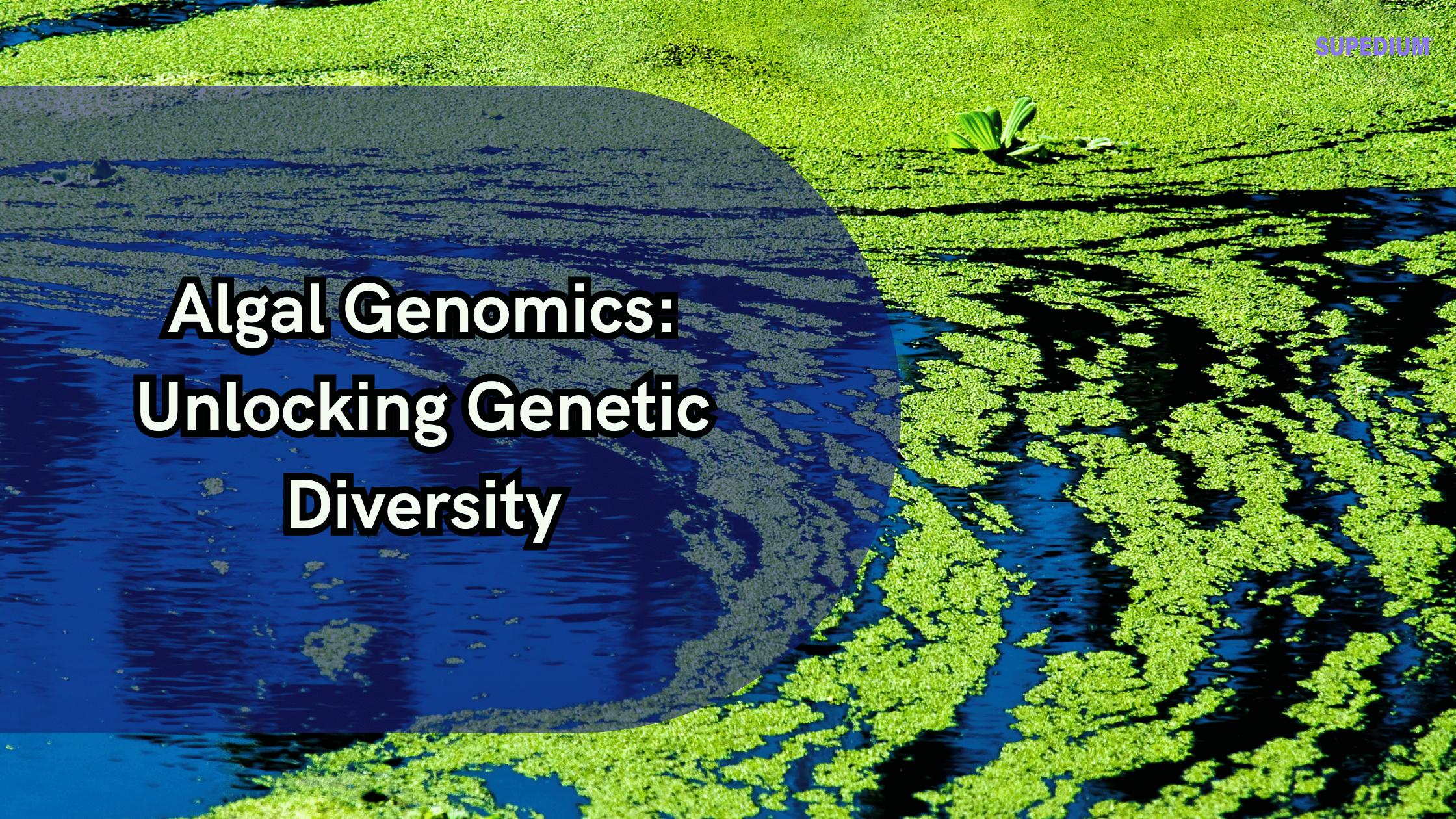Table of Contents
![]()
Algae, from the smallest microalgae to the largest macroalgae, are essential components of aquatic ecosystems and hold vast potential for biotechnology. Through genomic research, scientists are uncovering the genetic diversity within algae, which not only enhances our understanding of their ecological roles but also provides opportunities for innovation in industries like energy, medicine, and environmental conservation. This article explores the significance of algal genomics, focusing on how unlocking genetic diversity can benefit both the environment and human society.
Basics of Algal Genomics
What is Genomics?
Genomics refers to the study of the complete set of genes, or genome, of an organism. In the context of algae, genomics involves sequencing and analyzing the DNA of different species to understand their genetic makeup. This helps researchers identify the genes responsible for key functions such as photosynthesis, stress tolerance, and nutrient absorption.
Modern genomics technologies, such as high-throughput DNA sequencing and CRISPR gene editing, have revolutionized the way scientists study algae. These technologies enable detailed analysis of algal genomes, uncovering the genetic mechanisms that drive adaptation to varying environmental conditions.
Types of Algae and Their Genetic Characteristics
Algae are classified into two broad categories: microalgae and macroalgae. Microalgae, such as diatoms, green algae, and cyanobacteria, are unicellular organisms that play a pivotal role in global primary production. Macroalgae, or seaweeds, are larger multicellular organisms found in marine and freshwater environments.
While both types of algae contribute to ecosystem processes, their genomic structures differ. Microalgae tend to have smaller, simpler genomes, while macroalgae often have larger, more complex genomes. Understanding the genetic diversity within these groups helps scientists identify species with unique traits that can be leveraged for various applications, from biofuels to pharmaceuticals.
The Significance of Algal Genetic Diversity
Genetic diversity in algae is crucial for their ability to adapt to changing environmental conditions. Different algal species possess distinct genetic traits that enable them to thrive in various ecosystems, from the nutrient-rich waters of coastal regions to the extreme conditions of deep ocean environments. This genetic variation also underpins algae’s ability to withstand environmental stressors such as temperature fluctuations, salinity changes, and high radiation levels.
Unlocking this genetic diversity provides insights into how algae can be harnessed for purposes like environmental restoration, energy production, and climate change mitigation.
The Role of Algal Genomics in Understanding Environmental Adaptations
Genetic Mechanisms of Algal Adaptation
Algae have evolved to adapt to a wide range of environmental conditions. Genomic research has revealed several genetic mechanisms that enable algae to survive in extreme environments. For example, some species of algae have developed proteins that help them maintain cellular integrity in high-temperature conditions, while others possess specialized enzymes that allow them to metabolize nutrients in nutrient-poor waters.
These adaptations also include the ability to cope with high salinity, intense light exposure, and low oxygen levels. Understanding these mechanisms can inform strategies for cultivating algae in diverse environments, improving their use in biotechnological applications.
Algal Genomics and Climate Change
One of the most significant roles algae play in the global ecosystem is their contribution to carbon sequestration. Algae absorb carbon dioxide (CO2) during photosynthesis and convert it into organic carbon, which can be stored in the ocean or utilized by other organisms in the food web.
As climate change accelerates, understanding how algae adapt to higher temperatures, altered nutrient levels, and ocean acidification becomes crucial. Algal genomics offers insights into which species are most resilient to these stressors, paving the way for the development of algae-based solutions for climate change mitigation. For example, algae could be cultivated to capture CO2, helping to reduce greenhouse gas concentrations in the atmosphere.
Algal Adaptation to Different Habitats
Algae thrive in a wide range of habitats, from freshwater lakes to the vast expanse of the ocean. Different environmental factors, such as light availability, temperature, and salinity, influence the distribution of algal species. Genomic research helps identify the genetic factors that enable algae to survive in specific habitats.
Freshwater algae, for example, have evolved unique mechanisms to cope with the low salinity and variable nutrient availability of their environments. In contrast, marine algae are adapted to cope with the high salt content of seawater and the often nutrient-poor conditions of the open ocean. By studying these adaptations, scientists can better understand how to cultivate algae for various environmental and industrial purposes.
Algal Genomics and Biodiversity Conservation
Preserving Genetic Diversity in Algae
Algal genomics plays a key role in preserving genetic diversity, which is critical for the survival of algal species, particularly those that are rare or endangered. Through genome sequencing, researchers can track genetic variation across populations of algae, identifying which species may be at risk of genetic erosion due to environmental changes or overexploitation.
Conservation efforts can be enhanced by using genomic tools to monitor algal populations and assess the health of ecosystems. By identifying genetically distinct populations, scientists can prioritize conservation efforts and ensure that the genetic resources of algae are maintained for future generations.
Genomic Data for Ecological Monitoring
Algal genomics also provides valuable data for monitoring the health of aquatic ecosystems. By analyzing the genetic composition of algal communities, researchers can track changes in biodiversity and detect shifts in species composition due to environmental stressors, such as pollution, invasive species, or climate change.
This genomic monitoring approach can be used to identify early warning signs of ecosystem degradation, enabling timely intervention to protect vital aquatic habitats. Additionally, genomics can help detect harmful algal blooms (HABs) and trace the genetic origins of toxic algae strains, aiding in the prediction and management of HAB events.
Algal Genetic Resources for Sustainable Use
The genetic diversity of algae is an untapped resource for various industries, including biotechnology, pharmaceuticals, and biofuels. By understanding the genetic makeup of different algae species, researchers can identify traits that are useful for industrial applications, such as high lipid content for biofuel production or the ability to produce bioactive compounds with medicinal properties.
For example, certain algae species produce compounds with antiviral, anticancer, and antioxidant properties, making them valuable for drug development. Similarly, algae-based biofuels offer a renewable alternative to fossil fuels, reducing the environmental impact of energy production.
Applications of Algal Genomics in Biotechnology
Biofuels and Bioenergy Production
One of the most promising applications of algal genomics is in the production of biofuels. Algae, particularly microalgae, have the potential to produce large quantities of lipids, which can be converted into biodiesel. Through genetic engineering, scientists are working to enhance algae’s lipid production and optimize its growth conditions, making algae a viable alternative to fossil fuels.
Genomic research also aims to improve algae’s efficiency in carbon fixation, ensuring that the energy production process is both sustainable and carbon-neutral. By unlocking the genetic potential of algae, we can reduce our reliance on traditional energy sources and contribute to a cleaner, greener future.
Pharmaceutical and Nutraceutical Production
Algae are a rich source of bioactive compounds, many of which have therapeutic properties. Through genomic research, scientists are identifying the genes responsible for the production of these compounds, which can be harnessed for pharmaceutical and nutraceutical applications. Algae-derived substances such as antioxidants, omega-3 fatty acids, and anti-inflammatory compounds are already being used in dietary supplements and health products.
Furthermore, algae have shown promise in producing novel drugs for conditions like cancer, diabetes, and neurodegenerative diseases. By unlocking the genetic pathways involved in the synthesis of these compounds, algae can be engineered to produce drugs more efficiently.
Microbial-Algal Symbiosis for Industrial Applications
Microbial-algal interactions are another area where genomics plays a vital role. Algae and microbes often form symbiotic relationships that enhance their survival and productivity. For example, certain bacteria can help algae absorb nutrients more efficiently, while algae provide organic matter that supports microbial growth.
By understanding the genetic basis of these interactions, scientists can optimize microbial-algal partnerships for various industrial applications, such as wastewater treatment, resource recovery, and bioremediation. Engineering these symbiotic relationships could lead to more efficient and sustainable processes for environmental management and resource utilization.
Ethical and Environmental Considerations in Algal Genomics
Ethical Issues Surrounding Genetic Modification
While genetic modification holds great promise for improving algal productivity, it also raises ethical concerns. The manipulation of algae’s genetic makeup, particularly through gene editing technologies like CRISPR, could have unintended consequences for ecosystems if modified algae are released into the wild. Ethical questions also arise regarding the ownership of genetic resources and the potential exploitation of natural algal strains.
As a result, it is essential to establish ethical guidelines and regulatory frameworks for algal genomics research. Ensuring that genetic modifications do not negatively impact the environment or disrupt ecosystems will be key to the responsible development of algae-based technologies.
Environmental Risks of Engineered Algae
The release of genetically modified algae into the environment poses potential risks, including the unintended spread of modified genes to wild populations or the disruption of local ecosystems. Strict containment measures and monitoring systems will be necessary to mitigate these risks and prevent any negative ecological impacts.
Strategies for Responsible Research and Development
To ensure the safe and ethical development of algal genomics, international cooperation and regulation are essential. Collaborative efforts between researchers, governments, and industry stakeholders can help establish clear guidelines for the responsible use of genetic technologies in algae. Transparent research practices and long-term environmental monitoring will also be crucial in ensuring that the benefits of algal genomics outweigh the risks.
Conclusion
Algal genomics offers exciting opportunities to unlock genetic diversity and harness algae’s potential for addressing some of the world’s most pressing challenges, from climate change to sustainable energy production. By understanding the genetic makeup of algae, scientists can develop new biotechnological applications that support environmental sustainability and human well-being. However, ethical and environmental considerations must guide research in this field to ensure that algae’s potential is realized in a responsible and beneficial manner.
The future of algal genomics is promising, with the potential to revolutionize industries like energy, medicine, and environmental conservation. Through continued research and collaboration, we can unlock the full genetic potential of algae, paving the way for a more sustainable and resilient future.
Share This





Be the first to comment